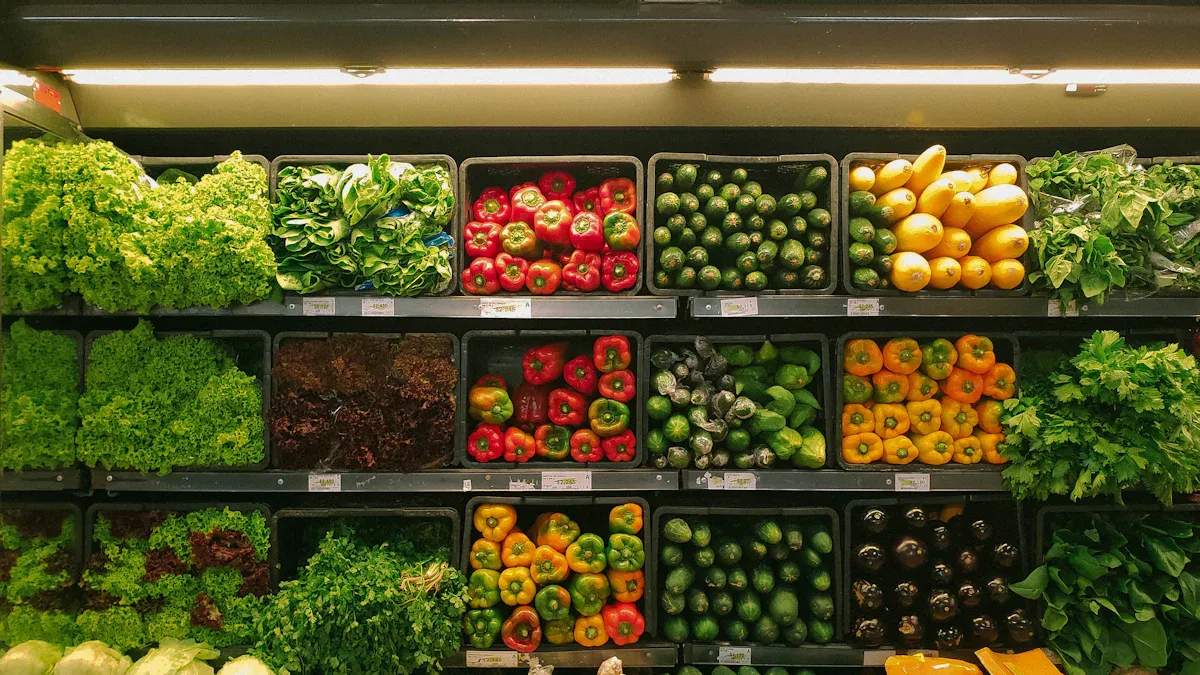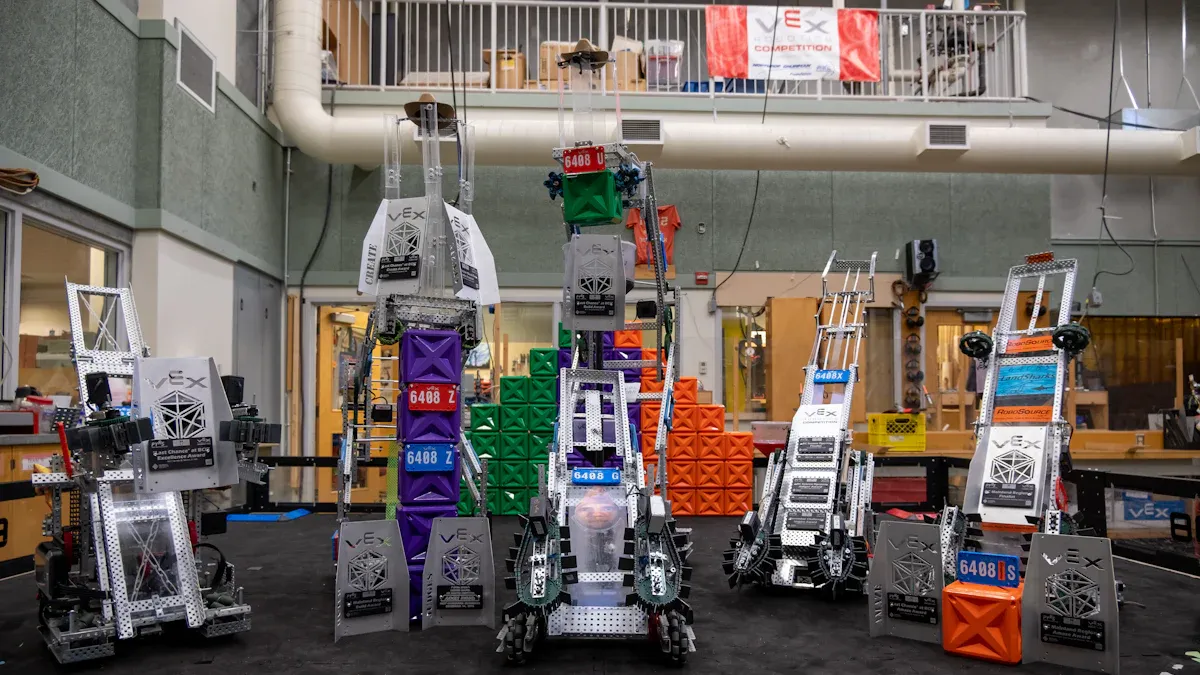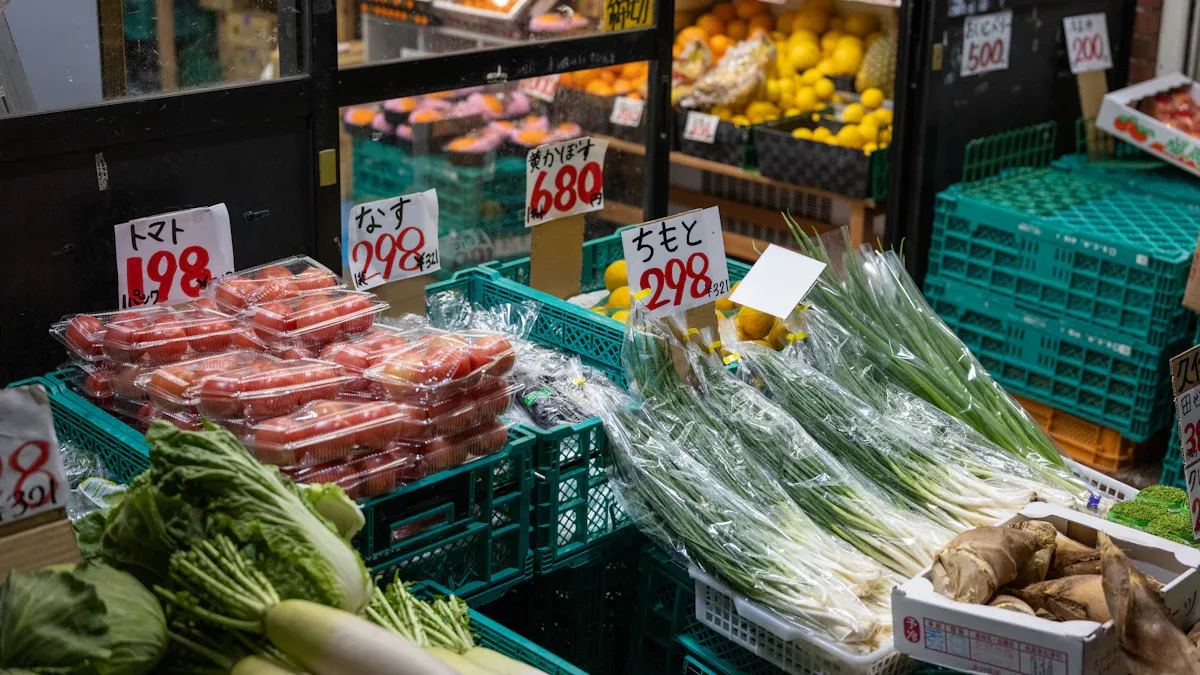Shelf restocking robots promise fresher finds every visit

Imagine you walk into your favorite store and see every shelf full of fresh things. You notice crisp apples and cold drinks, all set up nicely. Shelf restocking robots use special sensors and AI to watch inventory and keep shelves stocked. Smart shelves can tell workers when items will expire or need more stock. RFID systems help refill shelves and make orders faster, so you always get what you want. These tools make shopping easier and help stores give fresher options.
Key Takeaways
Shelf restocking robots use sensors and AI. They keep shelves filled with fresh products. This helps you find what you want each time you shop.
These robots help lower food waste. They spot expired items and restock fresh products first. This helps the environment and makes shopping better for you.
Robots scan shelves and send data to staff right away. This leads to up to 60% fewer empty shelves in stores.
Automation lets store workers focus on helping customers. Robots do the boring jobs. This makes your shopping experience better.
As technology gets better, shelf restocking robots will get smarter. Shopping will be easier, and fresher choices will always be there for you.
How shelf restocking robots work

Sensors and inventory tracking
When you go to a modern store, you may not see the technology at work. Shelf restocking robots use many sensors to watch every product on shelves. These sensors help robots look, scan, and know what is there and what needs more stock.
Here is a table that lists the main sensors these robots use:
Sensor Type | Description |
|---|---|
Barcode Scanning | Finds products on shelves by scanning barcodes. |
LIDAR | Sees the shelf layout and helps robots move around. |
Cameras | Gives pictures for finding products and checking shelf status. |
Infrared Sensors | Senses if products are on the shelves. |
Reed Switches | Checks inventory levels under spring-loaded shelves in real time. |
Inventory tracking is more accurate because robots scan shelves faster than people. Robots can reach high shelves and scan barcodes very well. This lowers mistakes and helps stores keep products in stock. When stores checked inventory by hand, mistakes could cost a lot of money—sometimes up to 30%. Now, with robots, stores have fewer empty shelves and better product choices.
Tip: Robots like Tally can check between 15,000 and 30,000 products every hour. This gives stores instant data about stock and price mistakes.
AI-powered restocking
Shelf restocking robots do more than count products. They use artificial intelligence (AI) to make smart choices about what to restock and when. This helps keep shelves full and neat for you.
Some common AI models in these robots are:
Object-detection models that find different products and decide where they go.
Arm movement detection models that help the robot pick up and place items.
Anomaly detection models that spot misplaced or dropped products.
Low stock detection models that warn the system when items are almost gone.
For example, the TX SCARA robot from Telexistence works in FamilyMart stores in Japan. It uses AI to refill cold compartments all day and night. The Tally robot, made by Simbe Robotics, scans shelves for inventory checks and is used in almost 1,000 stores on three continents. These robots let workers help you while robots do the boring jobs.
Autonomous movement
You may wonder how these robots move without hitting things. Shelf restocking robots use advanced sensors and smart navigation to travel through aisles and reach every shelf.
Robots like Tally use special sensors with 2D and 3D cameras. These cameras help the robot see shelves and aisles clearly. The robot uses depth perception and autofocus to see farther and more clearly than other tools. This helps the robot find products and avoid bumping into things.
Some robots also help with online orders. For example, the Taro cart from Migros guides workers to collect items for online shoppers. The cart tells workers which products to pick and helps them move fast from one item to the next. This teamwork between people and robots makes filling orders quicker and easier.
Note: Autonomous robots can gather shopping baskets and pick products for online orders. This makes your shopping trip smoother and more dependable.
With these tools, shelf restocking robots keep stores neat, products fresh, and shelves full. You always find what you need.
Fresher products

Expiry detection
You want fresh food when you shop. Shelf restocking robots help you get it. These robots use smart tools to find expired or bad items. They scan shelves with cameras and sensors. Robots look for problems like broken packages or spills. Robots also check the weight and feel of items. This helps make sure nothing is missing or spoiled. If something looks wrong, the robot sends an alert to store staff.
Here is a table that shows how these robots find expired or bad products:
Method | Description |
|---|---|
Computer Vision | Uses AI to spot damaged packaging or spills by recognizing unusual patterns. |
Multi-modal Sensing | Combines weight, vision, and vibration checks for better inventory monitoring. |
Anomaly Detection | Flags strange stock levels or customer actions, sending real-time alerts to staff. |
These systems keep expired products off the shelves. Stores use RFID and barcode technology to track every item. When a product is close to its expiration date, the system sends a warning. This helps staff remove old items quickly. Automated alerts and inventory software help stores manage stock better. This reduces waste. You see fresher products and fewer old items.
Tip: Expiry detection systems help stores cut down on waste. They make sure you always find fresh choices.
Prioritized restocking
Shelf restocking robots do more than remove expired goods. They also pick which products to restock first. Robots use AI and machine vision to look at every shelf. They check which items are running low. Robots also check which ones are closest to their expiration dates. Older products get restocked in front. This way, you buy the freshest items every time.
Here is a table that explains how robots choose what to restock:
Evidence Description | Details |
|---|---|
Use of AI and Machine Vision | Robots study shelf contents and arrange products based on freshness and demand. |
Stock Rotation Practices | Robots scan expiration dates and put older products in front to lower expired sales risk. |
Predictive Analytics | Robots use past sales data to guess which products will sell fast and need quick restocking. |
Robots like Tally and ShelfOptix™ have changed how stores handle fresh products. These robots scan shelves and give real-time updates about stock and freshness. Stores using these robots have seen big drops in food waste. Food waste in retail can reach 30%. With Tally, stores can cut this down to just 3.5%. That means up to 2.3 million tons of food waste can be prevented each year. Less waste means fewer greenhouse gas emissions. This helps the planet.
Two-thirds of grocery leaders say fresh products are the most important part of their stores.
Fresh food keeps shoppers happy and helps stores make more money.
Automation in fresh food sections helps stores work better and serve you faster.
You get fresher products. Stores waste less food. Shelf restocking robots make sure you always find the best items on the shelf.
Shopper & retailer benefits
Product availability
You want to find your favorite things each time you shop. Shelf restocking robots help make this happen. These robots scan shelves and check stock levels. This means you see fewer empty spots. Robots send instant data to store managers. Staff can restock items quickly. Stores using these robots have seen up to 60% fewer empty shelves. It is much easier for you to find what you want.
Evidence Description | Impact on Product Availability |
|---|---|
Robots scan shelves and update stock levels | Keeps products available for customers |
Robots send real-time data to store managers | Reduces empty shelves and enables quick restocking |
Stores report up to 60% drop in out-of-stock products | Increases likelihood of finding desired items |
Robots track inventory and send alerts for low stock | Minimizes chances of encountering empty shelves |
You also get correct prices and items that are easy to find. Robots tell staff about mistakes, so your shopping trip is better.
Efficiency & cost savings
Shelf restocking robots do more than fill shelves. They help stores save money and work faster. Robots do jobs like checking stock and refilling shelves. This lowers labor costs. Robots work all day without stopping. Staff can help you more. The store runs smoothly and prices stay fair.
Evidence Point | Description |
|---|---|
Automation of Repetitive Tasks | Robots handle dull tasks, allowing employees to focus on customer service. |
Cost Savings | Robots work continuously without breaks, reducing labor costs. |
Addressing Labor Shortages | Robots perform tasks that are hard to fill, ensuring customer needs are met. |
Stores like FamilyMart in Japan use robots to restock drinks and snacks. Canadian grocery stores use them to keep shelves neat and staff focused on you.
Waste reduction
Food waste is a big problem in stores. Shelf restocking robots help fix this by tracking products better. Robots like Tally help staff spot and remove old food. This cuts waste from 30% to just 3.5%. Less waste saves stores money and helps the planet.
Benefit | Description |
|---|---|
Waste Reduction | Shelf restocking robots help retailers reduce waste by optimizing inventory management. |
Energy Optimization | These robots contribute to minimizing energy consumption in store operations. |
Environmental Impact | They assist in reducing the overall environmental impact by ensuring efficient stocking practices. |
🛒 When stores waste less food, you get fresher choices and help protect the planet.
Challenges & future
Technical hurdles
Shelf restocking robots are helpful, but they have problems. Robots must move in busy stores without hitting people or displays. They need to work with old store systems, which is not easy. Here are some big problems:
Small stores find robots expensive at first.
Robots must match how stores already work, which is hard.
Workers worry about losing jobs, so stores train them for new tasks.
Robots need fixing and care to keep working.
Some shoppers feel nervous about robots, so stores help them feel safe.
Stores use Automated Guided Vehicles (AGVs) and Autonomous Mobile Robots (AMRs) to help robots move. AGVs follow set paths. AMRs choose their own way. Stores also connect robots to IoT devices for better talking and sharing data.
Adoption
Some stores do not use robots yet. Many stores face problems when trying to add robots. Here is a table that shows the main problems:
Barrier Type | Description |
|---|---|
High Initial Costs | Advanced robots cost a lot, which can stop smaller stores from buying them. |
Integration Challenges | Stores must make sure robots work well with old systems, which can be hard. |
Workforce Adaptation Issues | Staff need training or new hires to use robots successfully. |
Customer Acceptance Concerns | Stores must balance automation with friendly service to keep shoppers happy. |
Stores show how robots help keep shelves full and stores clean. When you see fresher food and cleaner aisles, you may like robots more. Companies like Ricoh help keep robots working well. Stores add robots slowly, so changes are easier for everyone.
Advancements
Robots will get even smarter soon. New AI tools help robots count items right away and guess what needs restocking. Robots share what they learn, so they get better faster. Services like ShelfOptix™ make restocking easier in busy stores.
Advancement Type | Description |
|---|---|
Robots give accurate, instant counts, helping stores with sensitive items. | |
AI-Powered Decision-Making | Robots use data to predict needs and fix problems before they happen. |
Cross-Embodiment Learning | Robots share skills, adapting quickly to new tasks and store layouts. |
New Robotic Services | Innovative tools like ShelfOptix™ improve restocking and inventory management. |
Robots now use computer vision and IoT analytics to scan shelves and spot low stock. Drones with RFID readers help scan hard-to-reach places. These new tools mean you will find fresher products and have an easier shopping trip.
Shelf restocking robots use AI to keep products fresh. They make it easy for you to find what you want. Robots help staff spend more time helping you. Stores save time and throw away less food. There are many good things for shoppers and stores:
Benefit | Description |
|---|---|
Robots keep shelves full and stop empty spaces. | |
Enhanced Customer Experience | Staff can help you more, so shopping is easier. |
Addressing Labor Shortages | Robots help when stores do not have enough workers. |
When you shop, you can find fresher items and get help faster. Smart technology makes your shopping trip better.
FAQ
How do shelf restocking robots know when to refill shelves?
Robots use sensors and cameras to scan shelves. They spot empty spots or low stock. The system sends alerts to restock items. You get products before they run out.
Are shelf restocking robots safe to use around shoppers?
Yes, these robots use sensors to avoid people and objects. You can shop safely while robots work. Stores train staff to help if you have questions.
Do robots replace store workers?
Robots handle simple, repetitive tasks. Staff focus on helping you and keeping the store clean. You get better service and more attention from workers.
What happens if a robot finds expired food?
The robot sends an alert to staff. Workers remove expired items right away. You see fresher products on the shelves.
See Also
Smart Vending Machines Offering Round-The-Clock Fresh Food Access
The Future of Retail Lies in AI-Driven Stores
Transforming Online Store Management With AI E-Commerce Tools
Essential Insights for Retailers on AI-Enhanced Corner Stores
